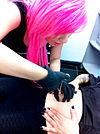Body modification
This article needs additional citations for verification. (December 2013) |

Body modification (or body alteration) is the deliberate altering of the human anatomy or human physical appearance.[1] In its broadest definition it includes skin tattooing, socially acceptable decoration (e.g., common ear piercing in many societies), and religious rites of passage (e.g., circumcision in a number of cultures), as well as the modern primitive movement.
Body modification is performed for a large variety of reasons, including aesthetics, sexual enhancement, rites of passage, religious beliefs, to display group membership or affiliation, in remembrance of lived experience, traditional symbolism such as axis mundi and mythology, to create body art, for shock value, and as self-expression, among other reasons.[1][2]
Definition

What counts as "body modification" varies in cultures. In western cultures, the cutting or removal of one's hair is not usually considered in the category of “body modification” despite it being literally modifying one’s body, and "body modification" is used to describe only less socially acceptable body alterations.
Body modification can be contrasted with body adornment by defining body modification as “the physical alteration of the physical body [...] can be temporary or permanent, although most are permanent and modify the body forever”[3]
History
This section needs expansion. You can help by adding to it. (September 2022) |
Social and cultural views
Social views of body modifications vary hugely depending on culture and the particular modifications. For example, many western culture view the cutting of head-hair as natural and not a modification because it is a necessary practicality to the extent that long hair in men is often seen as “wild”. Indeed, when British colonists arrived in the Americas and saw Native American men wearing their hair long, they took it as signs of primitivism and sexual promiscuity.[4] However, many other cultures avoid the cutting of head hair on the head, such as Sikh people, who maintain the hair in other ways, often with a hair knot and patka or turban.
Colonialism often affects views of certain body modifications - In the 1830s, English missionaries tried to outlaw tattooing in Samoa, banning it in missionary schools. The purpose of this ban was an attempt to “westernise” the Samoans, but during the time that tattooing was banned, it was still done in secret.[3]
Non-consensual body modification
"Disfigurement" and "mutilation" (regardless of any appreciation this always applies objectively whenever a bodily function is gravely diminished or lost) are terms used by opponents of body modification to describe certain types of modifications, especially non-consensual ones. Those terms are used fairly uncontroversially to describe the victims of torture, who have endured damage to ears, eyes, feet, genitalia, hands, noses, teeth, and/or tongues, including amputation, burning, flagellation, piercing, skinning, and wheeling.[citation needed]
Some invasive procedures that modify human genitals are performed with the informed consent of the patient, using anesthesia or sterilised surgical tools[5][6] The phrase "genital mutilation" is sometimes used to describe procedures that individuals are forced to undergo castration, male circumcision, and female genital mutilation in this way.[7] Intersex campaigners say that childhood modification of genitals of individuals with intersex conditions without their informed consent is a form of mutilation.[8]
Self-harm
In many ways self-mutilation is very different than body-modification. Body modification gives one the feeling of pride and excitement, giving one something to show off to others.[9] Alternately, those who self-mutilate typically are ashamed of what they've done and want to hide any evidence of harm. Body modification is explored for adornment, self-expression, and an array of many other positive reasons, while self-mutilation is inflicted because of mental or emotional stress and the inability to cope with psychological pain. Those who self-mutilate do so in order to punish themselves, express internal turmoil, and reduce severe anxiety.[10]
See also
References
- ^ a b Thompson, Tim; Black, Sue (2010). Forensic Human Identification: An Introduction. CRC Press. pp. 379–398. ISBN 978-1420005714. Retrieved 25 February 2013.
- ^ "What Is Body Modification?". Essortment. 16 May 1986. Archived from the original on 28 January 2016. Retrieved 20 March 2015.
- ^ a b DeMello, Margo (2007). Encyclopedia of Body Adornment. United States of America: Greenwood Press. ISBN 978-0313336959.
- ^ Dominick, Camello (1999). A Fiction of the Past: The Sixties in American History. United States of America: St. Martin's Griffin. ISBN 978-0312235017.
- ^ John R. Holman-Keith A. Stuessi (15 March 1999). "Adult Circumcision". American Family Physician. 59 (6): 1514–1518. PMID 10193593.
- ^ https://www.who.int/hiv/pub/malecircumcision/who_mc_local_anaesthesia.pdf[bare URL PDF]
- ^ Hellsten, SK (June 2004). "Rationalising circumcision: from tradition to fashion, from public health to individual freedom—critical notes on cultural persistence of the practice of genital mutilation". J Med Ethics. 30 (3): 248–53. doi:10.1136/jme.2004.008888. PMC 1733870. PMID 15173357.
- ^ Wilchins, Riki. "A Girl's Right to Choose: Intersex Children and Parents Challenge Narrow Standards of Gender". NOW Times. National Organization for Women. Retrieved 12 September 2012.
- ^ "Bradley University: Body Modification & Body Image". www.bradley.edu. Retrieved 14 October 2015.
- ^ "Self-injury/cutting Causes - Mayo Clinic". www.mayoclinic.org. Retrieved 14 October 2015.
- All articles with bare URLs for citations
- Articles with bare URLs for citations from November 2021
- Articles with PDF format bare URLs for citations
- Articles with short description
- Articles needing additional references from December 2013
- All articles needing additional references
- Articles to be expanded from September 2022
- All articles to be expanded
- Articles using small message boxes
- All articles with unsourced statements
- Articles with unsourced statements from February 2007
- Pages using div col with small parameter
- Body modification
- Cultural trends
- Underground culture